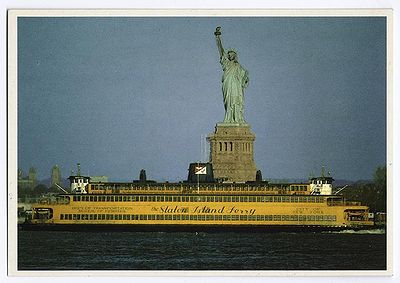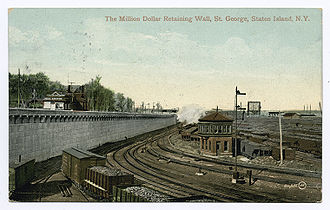User:Andrew.GurskyFrom The Peopling of New York City
Public Transportation on Staten IslandMore info to come in all sections Public transportation plays an important role in the everyday life of any large city. Aside from the environmental benefits of public transportation as a whole, public transportation is often the only means of transit for those who do not own vehicles. Staten Island’s public transportation seems to have been the subject of much controversy in recent years, with extreme differences in views. It would seem that the public transportation on Staten Island (and in New York as a whole) has been under fire by officials and commuters alike for variety of reasons. Forms of TransitFerryThe Ferry only has one route, between the St. George terminal at the north shore of Staten Island and Whitehall Terminal in lower Manhattan and departs twice per hour, on the hour and on the half hour, but operates once every fifteen minutes during peak hours. The Staten Island Ferry has been acting as a boat service between Staten Island and Manhattan for over two hundred years; however, ownership of the ferries have changed hands several times over the years. Today, the ferry shuttles hundreds of commuters, students, and regular travelers into Manhattan on a daily basis. These people typically view the ferry as a great convenience, for without it they may be forced to pay for an express bus to get to work or even drive into the city every morning. Not only does this act as a far more convenient method of transit but it also reduces the traffic on roads into Manhattan, and as a result, the amount of gas being used. OpinionsThe Ferry is generally held in high regard by Staten Islanders, most of the people I have spoken to have explained that they feel it is extremely convenient and far cheaper than taking an express bus or driving. During my interview with Professor Peters (displayed below), he mentions that while the Ferry is convenient, it operates under the assumption that everybody going into Manhattan is a commuter, and thus only operates every fifteen minutes during rush hours. BusBus service on Staten Island is the primary source of public transportation around the island. There was several bus routes and a comparably large amount of bus stops around the island, making inter-connection relatively simple. The bus lines have also been seeing renovation in recent years, with more and more hybrid buses hitting the roads. These hybrid buses are band new, and are greener than their standard predecessors. OpinionsIn spite of the fact that the buses are the primary source of transportation around the island, most people seem to only have bad things to say about them. In an interview with Amanda Davis, a CSI student, she reported: "The buses are always late...they look like they are gonna fall apart, but the new hybrids are nice." Every single person I spoke to said that they were displeased with the bus service on the island, that it was unreliable and that the buses were in poor condition. Professor Peters stated that the headway (time between buses) in Manhattan is approximately five to nine minutes, while it is about fifteen (or more) on Staten Island. He also mentioned that adding more buses to the routes has been difficult because there is simply not enough room to store the buses anymore (supposedly a simple problem to fix). TrainThe Staten Island Rapid Transit acts as the island's only heavy rail system (train system). It has only one route across the island, starting at the St. George Ferry Terminal and ending at Tottenville, along the way the train moves across the eastern part of the island exclusively. The train currently has a fixed cost of operation, because heavy rail systems generally do not change in their cost regardless of how often (or not so often) they are used. This is an advantage over systems such as buses or ferries. OpinionsThe train has earned the infamous nickname of "the train to nowhere" from most people who live on Staten Island. This is because the train is out of the way and useless to most islanders, unless they happen to live near a train stop, and their destination is along the rail's very linear path. Professor Peters feels that the train could have been a primary piece of public transportation had it been used to create a subway between Staten Island and Manhattan; however, tunneling is extremely expensive, especially between islands as far apart as Staten Island and Manhattan. CSI Bus ShuttleThe College of Staten Island currently runs its own bus shuttle to and from the St.George Ferry Terminal. It has been held in high regard due to its efficiency, and due to the fact that it has become extremely popular in only two years. The shuttle plans to advance, possibly adding more buses in the coming years. It currently plays a big role in reducing the campus's carbon footprint, by taking cars off the road and putting more people into public transportation. The buses are easily recognizable as they are obviously marked and eye-catching, which was supposedly done on purpose so that people would remember the bus easily. OpinionsThe shuttle bus has earned a positive reputation in the short time it has been around, mostly due to its efficiency. Jonathan Peters explains that the shuttle bus works so well is because it covers the three basics of transportation: it has fast/efficient service, has destinations which people actually need/want to go to, and has a clean and dignified waiting area at both stops. Interview with Professor PetersJonathan Peters is a professor of Finance at CSI, who currently conducts research regarding Public Transportation in New York City. The following video contains XX minutes of highlights from my over 40 minute interview with Prof. Peters.
Interview VideoInteresting Trivia-The CSI Shuttle Bus saves approximately 700 tons of carbon a year, due to taking cars off the road. -The Staten Island Ferry has roots all the way back to the 1700's; however, it was privately owned. -Public Transportation on Staten Island has remained mostly unchanged in terms of routes for nearly 150 years. -The Ferry was at one point owned by the Vanderbilts and contributed a great deal to the family fortune. -The Coast Guard considers the Ferry to be a great security hazard, as it shuttles hundreds of people across the water at a time, if an accident were to occur mid-passage, they could not help that many people out of the water quick enough. ReferencesHowe, Marvine. "NEIGHBORHOOD REPORT: LOWER MANHATTAN; Staten Island Ferry Revives a Battle of Boroughs.(The City Weekly Desk)." The New York Times. (April 3, 1994): NA. Opposing Viewpoints Resource Center. Gale. CUNY - Central Office. 20 Mar. 2010 <http://find.galegroup.com/ovrc/infomark.do?&contentSet=IAC-Documents&type=retrieve&tabID=T004&prodId=OVRC&docId=A174395580&source=gale&srcprod=OVRC&userGroupName=cuny_centraloff&version=1.0>. Newman, Andy. "Staten Islanders Learn to Cope With Reduced Bus Service.(Metropolitan Desk)." The New York Times. (Oct 4, 2006): B3(L). Opposing Viewpoints Resource Center. Gale. CUNY - Central Office. 20 Mar. 2010 <http://find.galegroup.com/ovrc/infomark.do?&contentSet=IAC-Documents&type=retrieve&tabID=T004&prodId=OVRC&docId=A152275160&source=gale&srcprod=OVRC&userGroupName=cuny_centraloff&version=1.0>. Newman, Andy. "Staten Island Riders Unimpressed by Plan to Limit Fare Hike.(Metropolitan Desk)." The New York Times. (Nov 9, 2004 pB3 col 02 (11 col): B3. Opposing Viewpoints Resource Center. Gale. CUNY - Central Office. 10 Apr. 2010 <http://find.galegroup.com/ovrc/infomark.do?&contentSet=IAC-Documents&type=retrieve&tabID=T004&prodId=OVRC&docId=A124321899&source=gale&srcprod=OVRC&userGroupName=cuny_centraloff&version=1.0>. "Less Traffic, a More Livable City.(Editorial Desk)(Letter to the Editor)." The New York Times. 151. 52073 (March 30, 2002): A14(L). Opposing Viewpoints Resource Center. Gale. CUNY - Central Office. 11 Apr. 2010 <http://find.galegroup.com/ovrc/infomark.do?&contentSet=IAC-Documents&type=retrieve&tabID=T004&prodId=OVRC&docId=A84276021&source=gale&srcprod=OVRC&userGroupName=cuny_centraloff&version=1.0>. Peters, Jonathan. Gordon, Cameron. “Present Problems and Future Solutions for Staten Island Transportation System.” Staten Island, New York. City University of New York, College of Staten Island. Davis, Amanda. Personal Interview, April 2, 2010. Peters, Jonathan. Personal Interview, April 15, 2010. |

